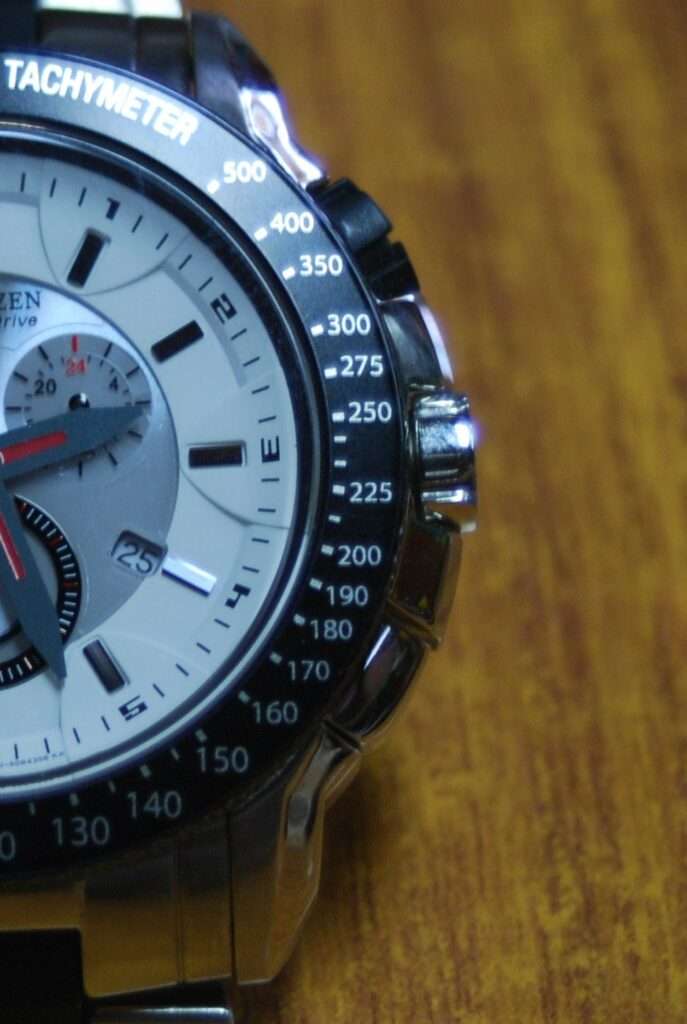A Marriage of Function and Form
In the world of horology, tachymeter bezels represent a perfect blend of functionality and design. Originally designed for professional use in aviation and auto racing, these bezels have become a celebrated feature in many classic and modern timepieces, beloved by collectors and enthusiasts for both their utility and aesthetic appeal.
The History and Evolution of the Tachymeter
Origins in Speed Measurement
- Early Usage: The tachymeter’s roots can be traced back to the early 20th century when measuring speed was crucial in both aviation and auto racing. Pilots and drivers needed a reliable way to calculate speed over a set distance, and the tachymeter offered a solution.
- Integration into Wristwatches: The first wristwatch tachymeter is believed to have appeared in the 1930s. Its incorporation into wristwatches revolutionized how speed and distance calculations were performed in fast-paced environments.
From Tool to Icon
- Design Evolution: Over the decades, tachymeter bezels have evolved in design. While early versions were printed on the dial, the post-WWII era saw the popularization of the external bezel, which became a signature feature in sports watches.
- Cultural Significance: Beyond their practical use, tachymeter bezels began to symbolize the thrill of racing and aviation, capturing the spirit of speed and adventure.
How Tachymeter Bezels Work: Understanding the Mechanics
The functionality of a tachymeter bezel, while initially seeming complex, is based on a simple principle. It is a scale typically found on the bezel of a chronograph watch, used to compute speed based on travel time or measure distance based on speed. Let’s break down how it works and its applications in a more digestible format.

Speed Calculation with a Tachymeter Bezel
- Start with the Basics: A tachymeter bezel is used in tandem with the chronograph function of a watch – the stopwatch feature. The bezel is marked with a scale that typically ranges from 60 to 500 or more.
- Step-by-Step Process:
- Start the Chronograph: Begin by starting the chronograph as the object (e.g., a car) passes a starting point.
- Stop at a Known Distance: Stop the chronograph when the object reaches a predefined distance, commonly one mile or one kilometer.
- Read the Speed: Look at the point on the tachymeter scale where the second hand is pointing. This number represents the speed of the object in units per hour (miles per hour or kilometers per hour).
- Example for Clarity:
- Imagine timing a car over a distance of one mile. You start the chronograph as the car passes a starting point. When the car crosses the one-mile marker, you stop the chronograph. If it took the car 45 seconds, the second hand would point to 80 on the tachymeter scale, indicating the car was traveling at 80 miles per hour.
Real-World Applications of the Tachymeter
- Beyond Racing and Aviation: While tachymeters are associated with professional racing and aviation, their utility extends to various everyday situations.
- Everyday Examples:
- Jogging in a Park: You can measure your jogging speed by timing how long it takes to run a known distance, like a lap around a park.
- Travel: If you’re on a train, you can calculate its speed by timing the journey between two stations a known distance apart.
- DIY Projects: For hobbyist projects involving moving parts, a tachymeter can be used to measure the speed of rotation or motion over a set distance.
The Tachymeter’s Practicality
Understanding how a tachymeter works demystifies this watch complication, revealing its practicality in various scenarios. While it might not replace digital tools in precision or ease of use, the tachymeter offers a unique, hands-on way to engage with time and speed, combining the charm of mechanical watches with practical functionality.
The Enduring Allure of the Tachymeter
The tachymeter bezel remains a fascinating and desirable feature in watches, a testament to the blend of innovation and tradition in watchmaking. It represents not just a tool for calculation but also a symbol of a bygone era of adventure and the ongoing quest for precision and excellence in timekeeping.

